When a young nurse named Sheila was asked about her religion, she said:
I believe in God. I’m not a religious fanatic. I can’t remember the last time I went to church. My faith has carried me a long way. It’s Sheilaism. Just my own little voice … It’s just try to love yourself and be gentle with yourself. You know, I guess, take care of each other. I think He would want us to take care of each other.
Robert Bellah, the sociologist who asked the question and recorded Sheila’s answer in his 1985 book, Habits of the Heart, said Sheilaism is an example how religious practice has moved from being a unified, public action to a private, personal system of belief. Bellah and his coauthors suggested that Sheilaism creates the logical possibility “of over 220 million American religions, one for each of us.” In the years that followed, “Sheilaists” began to identify themselves as “spiritual, but not religious.” Sociologists began to call them the “nones.”
Our question is, can liturgy change this trend toward radical individualism?
The answer is yes, but…
How advertising has influenced our liturgy
Before we can overcome Sheilaism, we have to first realize how much our worship life has been influenced by Sheilaism. The reform of the liturgy in the 1960s and 70s coincided almost exactly with the “golden age” of advertising that was fictionalized in the TV series, Mad Men.
As the reformers of the liturgy were trying to draw worshipers into a more communal, participative life of mutual care and concern, the ad men (and a few women) of Madison Avenue were hell-bent on appealing to and satisfying our individual cravings.
The resulting consumer culture that grew out of excessive marketing campaigns has spilled over into our churches. Parishioners approach worship with a consumer mentality. The liturgy is evaluated based on what I get out of it. Share on XThe resulting consumer culture that grew out of excessive marketing campaigns has spilled over into our churches. In any given parish, it is not unusual to have a family Mass, a youth Mass, a children’s Mass, a choir Mass, a contemporary Mass, a quiet Mass, or a praise and worship Mass (which sounds redundant!). Even if our liturgies are not so clearly labelled, parishioners approach worship with a consumer mentality. The liturgy is evaluated based on what I get out of it.
Freeing our liturgy from consumerism
At the beginning of Lent in 2019, Pope Francis said:
We need to free ourselves from the clutches of consumerism and the snares of selfishness, from always wanting more, from never being satisfied, and from a heart closed to the needs of the poor.
To do that, we will also have to free ourselves from the clutches of a consumerist mentality about the liturgy. Pope Francis emphasized this when speaking to the participants of the Plenary Assembly of the Congregation for Divine Worship and the Discipline of the Sacraments in February 2019:
The liturgy is not “the field of do-it-yourself,” but the epiphany of ecclesial communion. Therefore, “we,” and not “I,” resounds in prayers and gestures; the real community, not the ideal subject. When we look back to nostalgic past tendencies or wish to impose them again, there is the risk of placing the part before the whole, the “I” before the People of God, the abstract before the concrete, ideology before communion and, fundamentally, the worldly before the spiritual.
Let us be shaped by the liturgy
The solution to the self-centered consumer culture both outside and inside the church is given to us in the Constitution on the Sacred Liturgy:
For the liturgy, “through which the work of our redemption is accomplished,” most of all in the divine sacrifice of the Eucharist, is the outstanding means whereby the faithful may express in their lives, and manifest to others, the mystery of Christ and the real nature of the true Church. It is of the essence of the Church that she be both human and divine, visible and yet invisibly equipped, eager to act and yet intent on contemplation, present in this world and yet not at home in it; and she is all these things in such wise that in her the human is directed and subordinated to the divine, the visible likewise to the invisible, action to contemplation, and this present world to that city yet to come, which we seek. (2; emphasis added)
If we fully participate in the liturgy, we will be shaped by it in such a way that we can be “present in this world and yet not at home in it” and in such a way that “this present world [is subordinated] to that city yet to come.” In other words, to overcome Sheilaism, we have to participate fully in the liturgy.
But.., here’s the “but”: we have to change our paradigm of what we mean by “participation.” We’ll say more about that in a future post.
See also these related articles:
- You are witnesses
- Pastoral liturgists are “keepers of the fire”: The third level of liturgical participation
- Moving from technique to artistry: Three levels of liturgical participation
- How your liturgical ministry changes the world
- Do you remember the liturgical revolution of Vatican II?
- Liturgical participation: if you’re not doing, you’re not learning
- How Madison Avenue is sabotaging our worship
- A singing church is symbolic of the divine Trinity
- Singing with our ancestors in faith
- Music is the sacramental sign of God’s love for us
Image credit: Joshua Earle, Unsplash



Leave a Reply